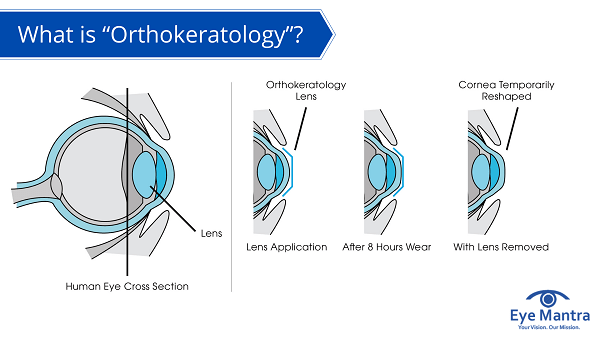
Orthokeratology often referred to as ortho-k is about using specially designed and fitted gas-permeable contact lenses that reshape the cornea temporarily to improve the vision of the eyes. It reduces refractive errors like myopia, hyperopia, and astigmatism. It is a way to get rid of the glasses without having eye surgery.
Orthokeratology can be compared to dental braces as it helps improve eye vision. They are preferably worn during the night so that they reshape the front surface of the cornea while you sleep. The improvement in your vision is reversible but it can be maintained if you keep wearing the lenses as directed by your ophthalmologist.
Contents
There is another name for ortho-k lens i.e., “corneal reshaping contact lenses” or “overnight contact lenses to correct or control myopia”.
You will be able to see without glasses or contact lenses for 1 or 2 days or perhaps longer than that.
The cornea is responsible for most of the eye’s ability to focus. Your ophthalmologist will analyze your cornea using an instrument called a corneal topographer and then he will design a lens for your eyes exclusively.
For creating a corneal map, light is reflected off the surface of the eye. The machine will not touch your eye and is pain-free. The shape and curves of your cornea are shown by the corneal topography map.
The lenses change how light is bent as it enters the eye. It flattens the center of the cornea. Ortho-k lenses usually are worn overnight and removed during the day. Ortho-k lenses are rigid, and gas permeable, and are robust enough to reshape the cornea. For keeping the eye healthy they allow oxygen to pass through.
The cornea stays flattened for a while when the ortho-k lenses are removed. Therefore, vision is improved temporarily and glasses are not needed. Your vision comes back to where you started once you stop wearing the lenses at night. The Refractive error will come back. So if want to maintain improved vision then should wear the lenses regularly overnight.
Corneal Refractive Therapy (CRT) is a proprietary lens design and fitting methodology of Paragon CRT which is a specific brand for corneal reshaping lenses. Although CRT is technically different from Orthokeratology, it is used for similar purposes.
VISION PROBLEMS THAT ORTHO-K CAN CORRECT
The effective management of type and amount of refractive error with orthokeratology differ on a case-by-case basis. Your ophthalmologist can suggest more efficiently about the same.
EXPECTATIONS FROM ORTHO-K
Ortho-k might take 2-3 weeks to attain the maximum improved vision. Some people might experience vision improvement in days.
Orthokeratology comes with an increased risk of infection (microbial/bacterial keratitis). Children and adolescents are more prone to this risk because they cannot keep their contact lenses clean and hygienic. Contact lens wear is the biggest risk factor for eye infection. Eye infection has serious consequences such as lifelong vision impairment.
The most serious risk of using ortho-k lenses is that it increases the risk of hypoxia in the eyes. It may result in swelling of the cornea and also clouding. The risk is sufficient enough that the Canadian Ophthalmologist Society (COS) does not authenticate this process.
Therefore, using ortho-k without the prescription of an ophthalmologist can have serious repercussions. You must get your vision checked regularly while using ortho-k.
People with mild to moderate myopia (with or without mild astigmatism) can be categorized as a good candidate for ortho-k. Ortho-k lenses are less risky in a way. Their effect is temporary and you can always stop wearing them.
Children and young adults who want to get rid of their glasses and cannot go for surgery are good candidates for ortho-k. People participating in contact sports or have dusty working conditions are always good candidates for ortho-k.
Optometrists and Ophthalmologists both perform the task of fitting the ortho-k lenses. A contact lens technician can also perform this task under the supervision of an optometrist or ophthalmologist.
Ortho-k is a special kind of fitting. Therefore not all eye doctors can perform this task. If want to go for orthokeratology, go to an eye doctor who is a specialist in fitting lenses.
Ortho-k lenses are quite expensive. People go for other cheaper alternatives and better-known methods before coming to orthokeratology. In some cases, insurance covers pay for ortho-k lenses. The cost of ortho-k, including fitting the lenses, may vary depending on the degree and type of refractive error.
The price range of ortho-k lenses varies from $1,000-$4,000. The replacement cost of ongoing lenses, solutions of the lens, and follow-up exams range between $300-$500 a year.
There are a few myths about Orthokeratology that need to be addressed here.
If you are going through mild or moderate degrees of myopia, hyperopia, or astigmatism, and glasses or contact lenses seem to be a lot to wear and carry, or if your want to go out glasses or lens-free then you can consider this new scientific alternative.
To know more about it, you can easily visit our website Eyemantra. If you are looking for other services like cataract surgery, Retina surgery or Ocuploplasty you can simply ring at +91-9711115191. Even you can simply mail us on eyemantra1@gmail.com.
Related Blogs:
What Are Progressive Lenses- Advantages Over Bifocal And Trifocal